Theodor Loos (1883-1954) was a German stage and screen actor between the 1910s and the 1950s. He became famous for his parts in Fritz Lang’s German films.

Small German collectors card by Ross Verlag. Photo: Ufa. Theodor Loos in Schuß im Morgengrauen/A Shot at Dawn (Alfred Zeisler, 1932).

German postcard by Verlag Herm. Leiser, Berlin Wilm., no. 6456. Photo: Becker & Maass.

German postcard by NPG, no. 957. Photo: Anny Eberth, Berlin.

German postcard by Photochemie, no. K 237. Photo: A. Binder, Berlin.
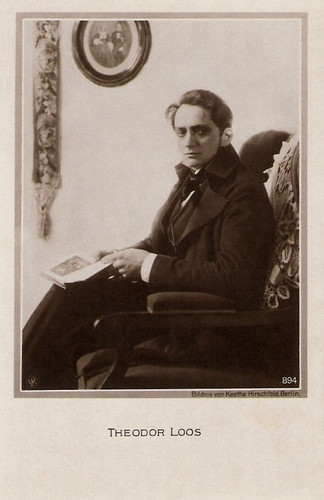
German postcard by NPG, no. 894. Photo: Käthe Hirschfeld, Berlin.
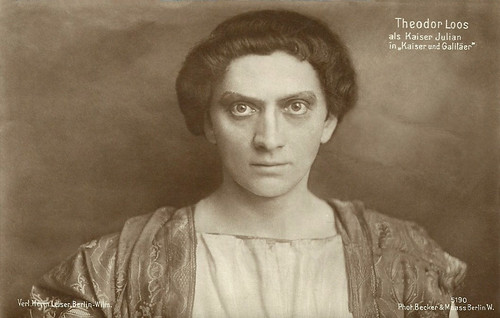
German postcard by Verlag Hermann Leiser, Berlin-Wilm., no. 5190. Photo: Becker und Maass, Berlin. 'Kaiser und Galiläer' (Emperor and Galilean) was not a film but a play by Henrik Ibsen, in which Loos played the part of Emperor Julian.
Theodor August Konrad Loos was born in Zwingenberg, Germany in 1883, as the son of a watchmaker and instrument manufacturer. After leaving school prematurely, he worked at an export firm for musical instruments in Leipzig and afterward for his uncle, an art dealer in Berlin. Then he decided to become an actor.
From 1913 on Loos played in theatres in Leipzig, Danzig and Frankfurt am Main, before performing in Berlin. In 1913 he also played his first film part and two years later his first leading role in the mystery drama Der geheimnisvolle Wanderer/The Mysterious Wanderer (William Wauer, 1915) with Ludwig Trautmann. Loos played in films by renowned directors such as Richard Oswald, Stellan Rye, Robert Wiene, Otto Rippert and Robert Reinert. Memorable early silent film titles are Die Rache des Homunculus/The Revenge of Homunculus (Otto Rippert, 1916) with Olaf Fönss, Christa Hartungen (Rudolf Biebrach, 1917) with Henny Porten, and Es werde Licht! II/Let There Be Light II (Richard Oswald, 1917-1918) with Eva Speyer.
He appeared again with Speyer in Die singende Hand/The Singing Hand (Arthur Wellin, 1918), with Else Kühne and Lia Borré in Die Buße des Richard Solm/The Penance of Richard Solm (Arthur Wellin, 1918), with diva Asta Nielsen in the films Nach dem Gesetz/According to the law (Willy Grunwald, 1919), and Der Reigen/The Merry-Go-Round (Richard Oswald, 1919). He also played in Othello (Dimitri Buchowetzki, 1921-1922) with Emil Jannings, and in Hanneles Himmelfahrt/Hannele's Ascension (Urban Gad, 1922). Loos played the title role in the humoristic period piece Friedrich Schiller (Curt Goetz, 1922-1923) on the adolescent years of the German playwright, shot on location in Stuttgart. The film, the debut of the film director Goetz, was previously considered lost but rediscovered in recent years and fully restored.
Loos’ finest hour, however, came when Fritz Lang had him perform the cowardly king Gunther in his two-part sequel Die Nibelungen (Fritz Lang, 1924). In the first part, Siegfrieds Tod/Siegfried, Gunther convinces Siegfried (Paul Richter) to conquer Brunhild (Hanna Ralph) for him, but when Brunhild discovers the fraud she urges Gunther to kill Siegfried, which he does with the help of Hagen von Tronje (Hans Adalbert Schlettow). In part two, Kriemhilds Rache/Kriemhild's Revenge, Siegfried’s wife Kriemhild (Margarethe Schön), sister of Gunther, takes revenge on the murderers of Siegfried, including her own brother.
A few years later, Lang asked Loos back for the part of the secretary Joseph/Josaphat in his Science-Fiction film Metropolis (Fritz Lang, 1925-1926). That year, he also starred in Das Lebenslied/The Song of Life (Arthur Bergen, 1927) with Erna Morena, Luther (Hans Kyser, 1927) starring Eugen Klöpfer, and Bigamie/Bigamy (Jaap Speyer, 1927) with Maria Jacobini. Other late silent films with loos were Anastasia, die falsche Zarentochter/Anastasia, the False Tsar's Daughter (Arthur Bergen, 1928) with Elizza La Porta and Camilla von Hollay, Ludwig der Zweite, König von Bayern/Ludwig II, King of Bavaria (William Dieterle, 1929-1930) in which Loos played Dr. Von Gudden, and Die stärkere Macht/The Increased Power (Gennaro Righelli, 1929) with Renée Heribel, Fritz Kortner and Alma Taylor.

German postcard by Rotophot in the Film Sterne series, no. 501/3. Photo: Decla. Hella Moja and Theodor Loos (far left) in the German silent film Die das Glück suchen/Those Searching for Happiness (1917). Odd is that this title does not appear in the databases Filmportal.de and IMDb. By looking at the serial numbers of the Film-Sterne series the film must be from 1917.
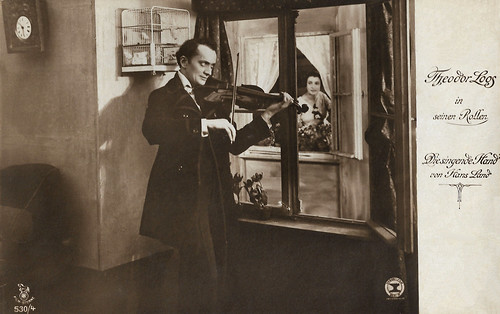
German postcard by Rotophot. in the Film-Sterne series, no. 530/4. Photo: Amboß / Film Dworsky & Co. Theodor Loos and Eva Speyer in Die singende Hand/The Singing Hand (1918).

German postcard by Rotophot. in the Film-Sterne series, no. 539/2. Photo: Theodor Loos in Die Buße des Richard Solm/The Penalty of Richard Solm (1918).

German postcard by Rotophot. in the Film-Sterne series, no. 540/2. Photo: Theodor Loos and Gertrud Beitz in Getrennte Welten/Seperated Worlds (1918).

German postcard by Ross Verlag, Berlin, no. 672/7, 1924. Photo: Decla-Ufa-Film. Theodor Loos in Die Nibelungen: Siegfried (Fritz Lang, 1924). Caption: Gunther.

German postcard by Verlag Ross, Berlin, no. 684/7. Photo: Carl-Wilhelm-Film / Terra Film. Theodor Loos and Heinrich George in the German silent film Soll und Haben/Debit and Credit (Carl Wilhelm, 1924), adapted from the novel by Gustav Freytag. The film had anti-Semitic and anti-Polish tendencies.
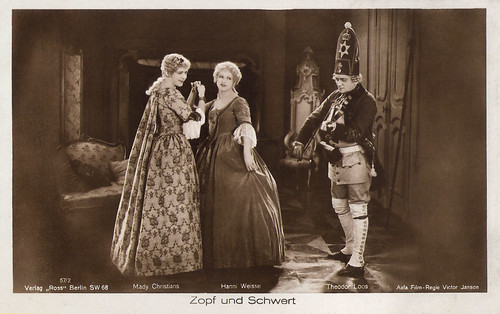
German postcard by Ross Verlag, no. 57/2. Photo: Aafa Film. Mady Christians, Hanni Weisse, and Theodor Loos in Zopf und Schwert - Die tolle Prinzessin/Braid and sword (Victor Janson, 1926).
Theodor Loos’ first sound film was the comedy Die grosse Sehnsucht/The Great Desire (Stefan Szekely, 1930), in which he played the lead as a film director who turns an extra (Camilla Horn) into a star. Other early sound films with Loos were Ariane (Paul Czinner, 1931) with Elisabeth Bergner, Die andere Seite/The Other Side (Heinz Paul, 1931) with Conrad Veidt, Trenck (Ernst Neubach, Heinz Paul, 1932) with Hans Stüwe and Dorothea Wieck, and Acht Mädels im Boot/Eight Girls in the Boat (Erich Waschneck, 1932) with Karin Hardt.
Returning to Fritz Lang, Loos was police commissioner Groeber in his masterpiece M (Fritz Lang, 1931) and Dr. Kramm in Das Testament des Dr. Mabuse/The Testament of Dr. Mabuse (1933). The last-mentioned film was forbidden by the Nazis because of its hidden criticism of Hitler and the Nazi regime, so it premiered in Budapest. In the 1930s Loos played not only countless film parts but also classic theatre: William Shakespeare, Friedrich Schiller, Gerhart Hauptmann, Henrik Ibsen, and August Strindberg, among which over 400 times in Peer Gynt. Under the Nazi regime, he was appointed 'Staatsschauspieler' (state actor).
He performed in Thea von Harbou’s directorial debut Elisabeth und der Narr/Elizabeth and the Fool (1934) with Hertha Thiele and Rudolf Klein-Rogge, Der Student von Prag/The Student of Prague (Artur Robison, 1935) with Loos as the devilish Dr. Carpis, Schlussakkord/Final Accord (Douglas Sirk, 1936) with Maria von Tasnady and Peter Bosse, and Schatten über St. Pauli/Shadows Over St. Pauli (Fritz Kirchhoff, 1938) with Harald Paulsen. He appeared in Veit Harlan’s films Der Herrscher/The Ruler (1936-1937) with Emil Jannings, and Jud Süß/Jew Süss (1940) with Ferdinand Marian, and in Hans Steinhoff’s films Der alte und der junge König/The Making of a King (1934-1935) with Jannings, Robert Koch (1939) with again Jannings, Rembrandt (1942) in which Loos played Jan Six, and Gabriel Dambrone (1943).
Other titles from the war era were Herbert Maisch’s Andreas Schlüter (1941-1942), in which Loos played prince-elector Frederick III, opposite Henrich George in the title role, and Titanic (Werner Klingler, Herbert Selpin, 1943) which starred Sybille Schmitz and Hans Nielsen, and in which Loos played a German scientist. During the war, Loos was head of Künstlerischen Wortsendungen (artistic verbal emissions) at the German Radio. He was also in high places on artistic and cultural boards. Loos didn’t have to serve in the war because of his parts in (propaganda-)films but his two sons did and they both died in the war.
At the end of the war, Loos fled via Prague to Salzburg but was rehabilitated by the French military government in 1947. He then performed again on stage in Tübingen and Stuttgart and also became a radio announcer. In 1954 Loos played his last film part as a minister in Rosen aus dem Süden/Roses from the South (Franz Antel, 1954), starring Maria Holst, and in the same year, he was awarded with the Grossverdienstkreuz of the Bundesrepublik. Theodor Loos died in 1954 in Stuttgart. He has played in over 170 films.

German postcard. Photo: Cicero Film / Distribution Deutsche Tonfilme. The 'fine fleur' of late silent German cinema stars, united for a photo for an early sound film company. Standing left to right: Franz Lederer, Walter Rilla, Theodor Loos, Camilla Horn, Fritz Rasp, and Walter Janssen, Sitting left to right: Paul Heidemann, Charlotte Susa, Betty Amann, Olga Tschechova, Maria Paudler, and Jack Trevor. Might be publicity for the early sound comedy Die grosse Sehnsucht/The Great Longing (Stefan Szekely/Steve Sekely, 1930), in which all acted, mostly as themselves - only Loos and Horn played characters. The plot was an excuse for 35 stars to debut in a talking picture.
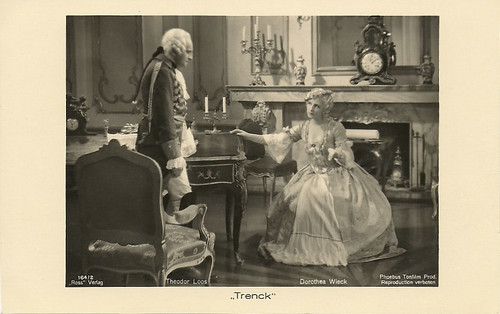
German postcard by Ross Verlag, no. 164/2. Photo: Phoebus Tonfilm prod. Theodor Loos and Dorothea Wieck in Trenck (Ernst Neubach, Heinz Paul, 1932). Collection: Didier Hanson.

German postcard by Ross Verlag, no. 7349/1, 1932-1933. Photo: O. Stein.

German postcard by Film-Foto-Verlag, no. A 3680/1. Photo: Tita Binz, Berlin / Terra Film.
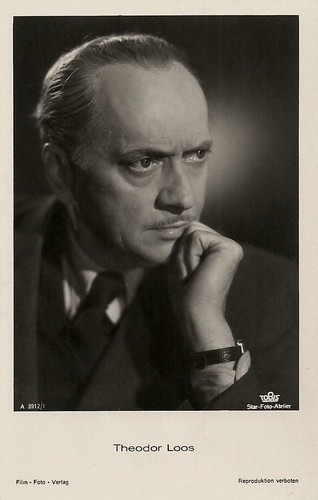
German postcard by Film-Foto-Verlag, no. A 3912/1. Photo Star Foto Atelier / Tobis.

German postcard by Film-Foto-Verlag, no. A 3530/1, 1941-1944. Photo: Tita Binz, Berlin.

German cigarette card in the series Unsere Bunten Filmbilder by Ross Verlag for Cigarettenfabrik Josetti, Berlin, no. 200. Photo: Nostra-Film.
Sources: Filmportal.de (German), Wikipedia (German and English), and IMDb.
This post was last updated on 1 April 2025.

Small German collectors card by Ross Verlag. Photo: Ufa. Theodor Loos in Schuß im Morgengrauen/A Shot at Dawn (Alfred Zeisler, 1932).

German postcard by Verlag Herm. Leiser, Berlin Wilm., no. 6456. Photo: Becker & Maass.

German postcard by NPG, no. 957. Photo: Anny Eberth, Berlin.

German postcard by Photochemie, no. K 237. Photo: A. Binder, Berlin.

German postcard by NPG, no. 894. Photo: Käthe Hirschfeld, Berlin.

German postcard by Verlag Hermann Leiser, Berlin-Wilm., no. 5190. Photo: Becker und Maass, Berlin. 'Kaiser und Galiläer' (Emperor and Galilean) was not a film but a play by Henrik Ibsen, in which Loos played the part of Emperor Julian.
The revenge of Homunculus
Theodor August Konrad Loos was born in Zwingenberg, Germany in 1883, as the son of a watchmaker and instrument manufacturer. After leaving school prematurely, he worked at an export firm for musical instruments in Leipzig and afterward for his uncle, an art dealer in Berlin. Then he decided to become an actor.
From 1913 on Loos played in theatres in Leipzig, Danzig and Frankfurt am Main, before performing in Berlin. In 1913 he also played his first film part and two years later his first leading role in the mystery drama Der geheimnisvolle Wanderer/The Mysterious Wanderer (William Wauer, 1915) with Ludwig Trautmann. Loos played in films by renowned directors such as Richard Oswald, Stellan Rye, Robert Wiene, Otto Rippert and Robert Reinert. Memorable early silent film titles are Die Rache des Homunculus/The Revenge of Homunculus (Otto Rippert, 1916) with Olaf Fönss, Christa Hartungen (Rudolf Biebrach, 1917) with Henny Porten, and Es werde Licht! II/Let There Be Light II (Richard Oswald, 1917-1918) with Eva Speyer.
He appeared again with Speyer in Die singende Hand/The Singing Hand (Arthur Wellin, 1918), with Else Kühne and Lia Borré in Die Buße des Richard Solm/The Penance of Richard Solm (Arthur Wellin, 1918), with diva Asta Nielsen in the films Nach dem Gesetz/According to the law (Willy Grunwald, 1919), and Der Reigen/The Merry-Go-Round (Richard Oswald, 1919). He also played in Othello (Dimitri Buchowetzki, 1921-1922) with Emil Jannings, and in Hanneles Himmelfahrt/Hannele's Ascension (Urban Gad, 1922). Loos played the title role in the humoristic period piece Friedrich Schiller (Curt Goetz, 1922-1923) on the adolescent years of the German playwright, shot on location in Stuttgart. The film, the debut of the film director Goetz, was previously considered lost but rediscovered in recent years and fully restored.
Loos’ finest hour, however, came when Fritz Lang had him perform the cowardly king Gunther in his two-part sequel Die Nibelungen (Fritz Lang, 1924). In the first part, Siegfrieds Tod/Siegfried, Gunther convinces Siegfried (Paul Richter) to conquer Brunhild (Hanna Ralph) for him, but when Brunhild discovers the fraud she urges Gunther to kill Siegfried, which he does with the help of Hagen von Tronje (Hans Adalbert Schlettow). In part two, Kriemhilds Rache/Kriemhild's Revenge, Siegfried’s wife Kriemhild (Margarethe Schön), sister of Gunther, takes revenge on the murderers of Siegfried, including her own brother.
A few years later, Lang asked Loos back for the part of the secretary Joseph/Josaphat in his Science-Fiction film Metropolis (Fritz Lang, 1925-1926). That year, he also starred in Das Lebenslied/The Song of Life (Arthur Bergen, 1927) with Erna Morena, Luther (Hans Kyser, 1927) starring Eugen Klöpfer, and Bigamie/Bigamy (Jaap Speyer, 1927) with Maria Jacobini. Other late silent films with loos were Anastasia, die falsche Zarentochter/Anastasia, the False Tsar's Daughter (Arthur Bergen, 1928) with Elizza La Porta and Camilla von Hollay, Ludwig der Zweite, König von Bayern/Ludwig II, King of Bavaria (William Dieterle, 1929-1930) in which Loos played Dr. Von Gudden, and Die stärkere Macht/The Increased Power (Gennaro Righelli, 1929) with Renée Heribel, Fritz Kortner and Alma Taylor.

German postcard by Rotophot in the Film Sterne series, no. 501/3. Photo: Decla. Hella Moja and Theodor Loos (far left) in the German silent film Die das Glück suchen/Those Searching for Happiness (1917). Odd is that this title does not appear in the databases Filmportal.de and IMDb. By looking at the serial numbers of the Film-Sterne series the film must be from 1917.

German postcard by Rotophot. in the Film-Sterne series, no. 530/4. Photo: Amboß / Film Dworsky & Co. Theodor Loos and Eva Speyer in Die singende Hand/The Singing Hand (1918).

German postcard by Rotophot. in the Film-Sterne series, no. 539/2. Photo: Theodor Loos in Die Buße des Richard Solm/The Penalty of Richard Solm (1918).

German postcard by Rotophot. in the Film-Sterne series, no. 540/2. Photo: Theodor Loos and Gertrud Beitz in Getrennte Welten/Seperated Worlds (1918).

German postcard by Ross Verlag, Berlin, no. 672/7, 1924. Photo: Decla-Ufa-Film. Theodor Loos in Die Nibelungen: Siegfried (Fritz Lang, 1924). Caption: Gunther.

German postcard by Verlag Ross, Berlin, no. 684/7. Photo: Carl-Wilhelm-Film / Terra Film. Theodor Loos and Heinrich George in the German silent film Soll und Haben/Debit and Credit (Carl Wilhelm, 1924), adapted from the novel by Gustav Freytag. The film had anti-Semitic and anti-Polish tendencies.

German postcard by Ross Verlag, no. 57/2. Photo: Aafa Film. Mady Christians, Hanni Weisse, and Theodor Loos in Zopf und Schwert - Die tolle Prinzessin/Braid and sword (Victor Janson, 1926).
State actor under the Nazi regime
Theodor Loos’ first sound film was the comedy Die grosse Sehnsucht/The Great Desire (Stefan Szekely, 1930), in which he played the lead as a film director who turns an extra (Camilla Horn) into a star. Other early sound films with Loos were Ariane (Paul Czinner, 1931) with Elisabeth Bergner, Die andere Seite/The Other Side (Heinz Paul, 1931) with Conrad Veidt, Trenck (Ernst Neubach, Heinz Paul, 1932) with Hans Stüwe and Dorothea Wieck, and Acht Mädels im Boot/Eight Girls in the Boat (Erich Waschneck, 1932) with Karin Hardt.
Returning to Fritz Lang, Loos was police commissioner Groeber in his masterpiece M (Fritz Lang, 1931) and Dr. Kramm in Das Testament des Dr. Mabuse/The Testament of Dr. Mabuse (1933). The last-mentioned film was forbidden by the Nazis because of its hidden criticism of Hitler and the Nazi regime, so it premiered in Budapest. In the 1930s Loos played not only countless film parts but also classic theatre: William Shakespeare, Friedrich Schiller, Gerhart Hauptmann, Henrik Ibsen, and August Strindberg, among which over 400 times in Peer Gynt. Under the Nazi regime, he was appointed 'Staatsschauspieler' (state actor).
He performed in Thea von Harbou’s directorial debut Elisabeth und der Narr/Elizabeth and the Fool (1934) with Hertha Thiele and Rudolf Klein-Rogge, Der Student von Prag/The Student of Prague (Artur Robison, 1935) with Loos as the devilish Dr. Carpis, Schlussakkord/Final Accord (Douglas Sirk, 1936) with Maria von Tasnady and Peter Bosse, and Schatten über St. Pauli/Shadows Over St. Pauli (Fritz Kirchhoff, 1938) with Harald Paulsen. He appeared in Veit Harlan’s films Der Herrscher/The Ruler (1936-1937) with Emil Jannings, and Jud Süß/Jew Süss (1940) with Ferdinand Marian, and in Hans Steinhoff’s films Der alte und der junge König/The Making of a King (1934-1935) with Jannings, Robert Koch (1939) with again Jannings, Rembrandt (1942) in which Loos played Jan Six, and Gabriel Dambrone (1943).
Other titles from the war era were Herbert Maisch’s Andreas Schlüter (1941-1942), in which Loos played prince-elector Frederick III, opposite Henrich George in the title role, and Titanic (Werner Klingler, Herbert Selpin, 1943) which starred Sybille Schmitz and Hans Nielsen, and in which Loos played a German scientist. During the war, Loos was head of Künstlerischen Wortsendungen (artistic verbal emissions) at the German Radio. He was also in high places on artistic and cultural boards. Loos didn’t have to serve in the war because of his parts in (propaganda-)films but his two sons did and they both died in the war.
At the end of the war, Loos fled via Prague to Salzburg but was rehabilitated by the French military government in 1947. He then performed again on stage in Tübingen and Stuttgart and also became a radio announcer. In 1954 Loos played his last film part as a minister in Rosen aus dem Süden/Roses from the South (Franz Antel, 1954), starring Maria Holst, and in the same year, he was awarded with the Grossverdienstkreuz of the Bundesrepublik. Theodor Loos died in 1954 in Stuttgart. He has played in over 170 films.

German postcard. Photo: Cicero Film / Distribution Deutsche Tonfilme. The 'fine fleur' of late silent German cinema stars, united for a photo for an early sound film company. Standing left to right: Franz Lederer, Walter Rilla, Theodor Loos, Camilla Horn, Fritz Rasp, and Walter Janssen, Sitting left to right: Paul Heidemann, Charlotte Susa, Betty Amann, Olga Tschechova, Maria Paudler, and Jack Trevor. Might be publicity for the early sound comedy Die grosse Sehnsucht/The Great Longing (Stefan Szekely/Steve Sekely, 1930), in which all acted, mostly as themselves - only Loos and Horn played characters. The plot was an excuse for 35 stars to debut in a talking picture.

German postcard by Ross Verlag, no. 164/2. Photo: Phoebus Tonfilm prod. Theodor Loos and Dorothea Wieck in Trenck (Ernst Neubach, Heinz Paul, 1932). Collection: Didier Hanson.

German postcard by Ross Verlag, no. 7349/1, 1932-1933. Photo: O. Stein.

German postcard by Film-Foto-Verlag, no. A 3680/1. Photo: Tita Binz, Berlin / Terra Film.

German postcard by Film-Foto-Verlag, no. A 3912/1. Photo Star Foto Atelier / Tobis.

German postcard by Film-Foto-Verlag, no. A 3530/1, 1941-1944. Photo: Tita Binz, Berlin.

German cigarette card in the series Unsere Bunten Filmbilder by Ross Verlag for Cigarettenfabrik Josetti, Berlin, no. 200. Photo: Nostra-Film.
Sources: Filmportal.de (German), Wikipedia (German and English), and IMDb.
This post was last updated on 1 April 2025.
No comments:
Post a Comment